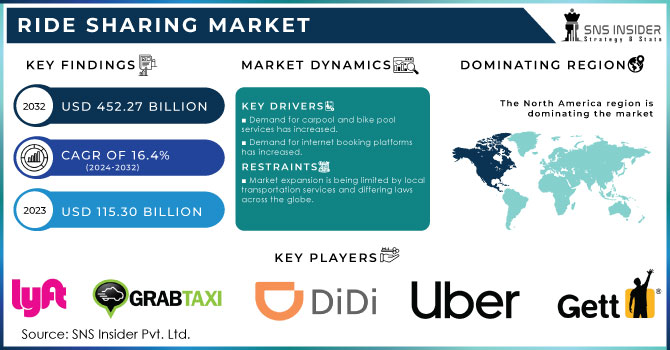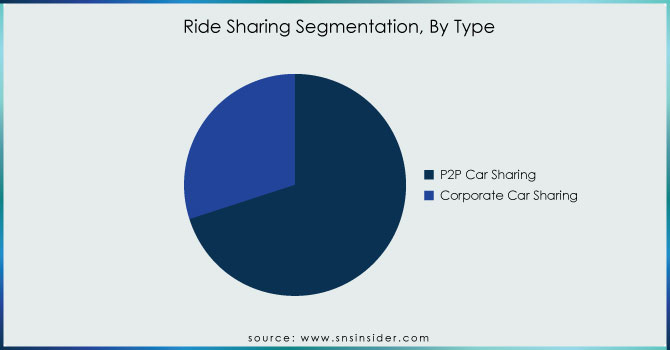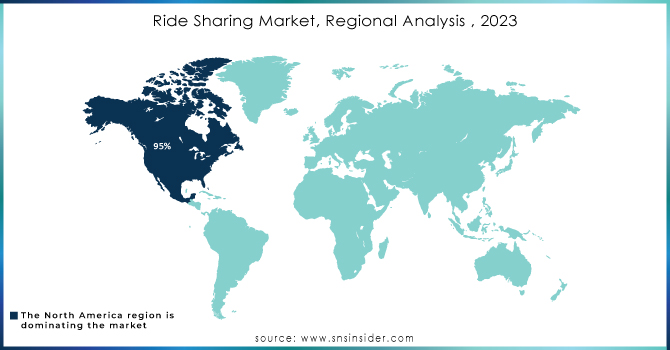Ride Sharing Market Report Scope & Overview:

Get More Information About This Research Report - Request For Sample Report
Ride Sharing Market Size was valued at USD 115.30 billion in 2023 and is expected to reach USD 452.27 billion by 2032 and grow at a CAGR of 16.4% over the forecast period 2024-2032.
Ride sharing is the act of sharing a ride with another passenger, preferably in the same direction. It can be used by numerous travelers on a shared basis. There is usually a middleman that provides an app that allows riders and drivers to find and connect in order to use these ride-share services. A passenger can schedule a shared ride through the use of e-hailing, which is short for electronic hailing, by making a phone call and sending a text message, or by going to the actual location of the service provider and using the internet to access a smartphone application or website. Taxis and cabs are available for passengers to reserve or hire for predetermined trips along routes that the passenger establishes in advance. The ride-sharing market came into being at the confluence of key factors urbanization that led to increased traffic congestion and a lack of proper parking options for personal car owners, coupled with millennial preferences toward experiences rather than ownership a push for wanting easy hassle-free transport. Further, rising fuel prices and improved environmental consciousness increasingly drove consumers toward shared mobility solutions. Many US ride-sharing consumers, especially within cities, have chosen ride-sharing services because it is felt that public transit offerings are inadequate, making up over 40% of riders. Furthermore, realizing real-time tracking, fare estimates, and cashless payments, technology has made this process more user-friendly, which in turn will help promote market growth.
Ride-sharing services typically make use of passenger cars, motorbikes, scooters, minivans, vans, buses and coaches, auto-rickshaws, and other types of vehicles. Ride-sharing is a relatively new concept in the mobility sector that has grown in popularity alongside car-sharing, car-hailing, and carpooling. The ride-sharing system operates by people offering and accepting rides at the driver's convenience. Ride-sharing makes short and lengthy travels easier by providing one-way and two-way rides. Because many people in economically developing countries do not own cars, they rely on car-hailing services.
MARKET DYNAMICS:
KEY DRIVERS:
-
Demand for carpool and bike pool services has increased.
-
Demand for internet booking platforms has increased.
-
The rise in the cost of owning a car is expected to propel the market forward.
The growing expenses associated with owning a car act as a significant changing force for the ride-sharing market. The rising cost of vehicles, insurance premium prices, fuel prices, and maintenance are reducing the attractiveness of owning cars, particularly in urban areas. Another trend picking up steam is that millennials and Generation Z are increasingly opting for car-less lives. For instance, in the US, there has been a 5% rise in the use of public transport in the past two years, which shows a changing preference in transport. As more and more remote work is adopted, the necessity of commuting daily has decreased, hence reliance on personal vehicles has decreased.
RESTRAINTS:
-
Improvement of the public transportation system.
-
Market expansion is being limited by local transportation services and differing laws across the globe.
The presence of ride-sharing services usually provokes strong reactions from well-established taxi markets through protests and lawsuits, creating entry barriers. For instance, traditional taxi medallions in New York City have lost more than 90% of their value since the entry of Uber and Lyft—just one case of the disruptiveness to incumbent players. Beyond these challenges, regulations vary in many countries for ride-sharing firms. The US has been a lead market, with more than 70% of Americans claiming familiarity with ride-sharing, but tighter regulation in Europe and Asia has inhibited the pace of expansion.
Market, By Type:
The global market has been divided into P2P car sharing, and Corporate Car Sharing based on the type segment. It is expected that the P2P car-sharing segment would lead the car-sharing market. P2P car sharing is a sort of vehicle sharing in which users share their automobiles with other travelers. A further benefit of the P2P approach is that the owner is present in the vehicle at all times.

Get Customized Report as per your Business Requirement - Request For Customized Report
Market, By Service Type:
The global market has been divided into E-hailing, Car sharing, Station-based mobility, and Car rental based on the service type segment. During the projected period, the e-hailing segment is expected to be the largest ride-sharing market. E-expanding hailing's popularity can be ascribed to a variety of factors, including the convenience of online reservations, increasing traffic congestion, improved passenger experience, and increased government efforts to raise public awareness about the dangers of air pollution.
Market, By Distance:
The global market has been divided into Long Distance, and Short Distance based on the commute type segment. Short-distance and corporate commutes are expected to dominate the market. However, because of the increasing tendency of ride-hailing platform providers to delve into these services through their current platforms, the short distance type is expected to lead during the projected period.
REGIONAL ANALYSIS:
North America was the most successful region, with the United States accounting for approximately 95% of the regional market share. On the other hand, it is projected that Asia would eventually overtake North America within the period of the forecast. Due to the region's huge number of cities and towns that are undergoing fast urbanization, Asia is a prospective market for ride-sharing services. China and India, the two most populous countries in the world, both call this area of the world their home. China already holds a dominant position in the market for ride-hailing services and is expected to experience explosive growth in ride-sharing over the course of the projection period.
Although India has had healthy expansion over the past few years, the business sector there has not yet made the most of the opportunities presented by the country. There is still some resistance to the idea being implemented in some European nations, like Germany, therefore the content is not yet fully functional. Over the course of the past ten years, developed nations such as the United Kingdom and France have enthusiastically adopted platforms for sharing four-wheelers and bicycles.

KEY PLAYERS:
Uber Technologies Inc. (U.S.), Gett, Lyft Inc. (U.S.), Didi Chuxing Technology Co. (China), GrabTaxi Holdings Pte. Ltd. (Singapore), car2go (Germany), Cabify (Spain), Careem (UAE), Bolt Technology, Zimride are some of the affluent competitors with significant market share in the Ride Sharing Market.
| Report Attributes | Details |
|---|---|
| Market Size in 2023 | US$ 115.30 Billion |
| Market Size by 2032 | US$ 452.27 Billion |
| CAGR | CAGR of 16.4% From 2024 to 2032 |
| Base Year | 2023 |
| Forecast Period | 2024-2032 |
| Historical Data | 2020-2022 |
| Report Scope & Coverage | Market Size, Segments Analysis, Competitive Landscape, Regional Analysis, DROC & SWOT Analysis, Forecast Outlook |
| Key Segments |
|
| Regional Analysis/Coverage | North America (US, Canada, Mexico), Europe (Eastern Europe [Poland, Romania, Hungary, Turkey, Rest of Eastern Europe] Western Europe] Germany, France, UK, Italy, Spain, Netherlands, Switzerland, Austria, Rest of Western Europe]), Asia Pacific (China, India, Japan, South Korea, Vietnam, Singapore, Australia, Rest of Asia Pacific), Middle East & Africa (Middle East [UAE, Egypt, Saudi Arabia, Qatar, Rest of Middle East], Africa [Nigeria, South Africa, Rest of Africa], Latin America (Brazil, Argentina, Colombia, Rest of Latin America) |
| Company Profiles |
Uber Technologies Inc. (U.S.), Gett, Lyft Inc. (U.S.), Didi Chuxing Technology Co. (China), GrabTaxi Holdings Pte. Ltd. (Singapore), car2go (Germany), Cabify (Spain), Careem (UAE), Bolt Technology, Zimride |
| Key Drivers | •Demand for carpool and bike pool services has increased. •Demand for internet booking platforms has increased. |
| RESTRAINTS | •Improvement of the public transportation system. •Market expansion is being limited by local transportation services and differing laws across the globe. |

